|
Hurricane Stories 2005 Season
What a busy hurricane season 2005 was for all of us on the Gulf Coast! Landfall wrestled with three major blows, Tropical Storm Cindy, Hurricane Dennis, and Hurricane Katrina. By the time Hurricane Rita blew through, we were safely tied up at Homeport Marina in Gulf Shores, and hardly felt any wind or rain at all.
July 6, Tropical Storm Cindy: We were in California at Sharon's Burrows Family Reunion in Santa Cruz, and heading out on Capt. Sharon's birthday-present whale watching trip on Monterey Bay, when we got the call from the marina: "Did you hear about Tropical Storm Cindy? Well, we had some flooding here; your boat's ok, but your car and motorcycle are flooded. Oh, and by the way, Hurricane Dennis is looking pretty nasty, and headed our way. What are you going to do about your boat for the hurricane?"
So much for the reunion; we left for Mobile the next morning. The Honda Civic was totaled, and the Harley Davidson motorcycle needed new pipes. But Landfall was fine.
July 9, Hurricane Dennis: We took Landfall up to Big Briar Creek, a well-used hurricane hole off the Mobile-Tensaw Cutoff, about 25 miles up the Mobile River. Capt. Sharon and First Mate Jasmine left the boat to stay with friends ashore. Capt. Tracy rode out the storm on Landfall. Dennis was not a severe storm, and while Tracy had an exciting day of it, we were able to head back to our marina the next day.
August 25, Hurricane Katrina, Round 1: When Hurricane Katrina became a Category 1 hurricane and made landfall on the Miami-Dade/Broward county line during the evening of August 25th, Capt. Sharon was in Stuart, Florida, at the Chapman School of Seamanship, taking classes for her U.S. Coast Guard Captain's license, Towing Endorsement and Marine Radio Operator's Permit. All that day, there were wild winds and drenching rain in Stuart. Katrina moved across south Florida, dumping over a foot of rain, toppling trees and power lines and damaging homes and businesses in Miami-Dade and Broward counties. After crossing south Florida and entering the Gulf of Mexico, Katrina began to strengthen—-and we got worried.
August 28, Hurricane Katrina, Round 2: Katrina reached Category 5 strength on August 28th, about 250 miles south-southeast of the mouth of the Mississippi river. Katrina's winds reached their peak intensity of 175 mph winds and the pressure fell to 902 mb, the fourth lowest pressure on record. What follows is Capt. Sharon's account of our encounter with Hurricane Katrina.
What a Ride ...
“We’re going into the trees!” I yelled above the roar of rushing water and shrieking wind. Landfall was headed straight for the wooded shoreline. “Just do your best!” Tracy yelled back from the bow.
I was at the helm, pushing the engine to full throttle, trying to buy time while Tracy worked frantically to clear the tons of debris that had ensnared our anchor rodes and ripped our anchors out of the mud. As absurd as it might seem, at that moment I actually thought of Scotty on Start Trek, yelling to Captain Kirk, “I’m giving her all she’s got, Captain!” as I gunned our engine to its limit.
Landfall was still charging backwards with the surging current and ferocious wind. As the boat raced toward the shoreline, I could now see that just around the bend in the creek, the roiling current was headed straight up a small tributary toward a railroad trestle bridge. The rusty steel bridge was about 6 feet high.
Looking further around the bend, in the main creek, I could see a line of boats anchored and tied off to the trees on both shores, tied by spider webs of lines.
Hmm… should we slam into the trees onshore, be dismasted by the railroad trestle bridge, or just pile up onto the anchored boats?
I didn’t like my options. It was at that point that I yelled to Tracy, because I had decided that landing the boat in the trees was the best choice. If it came to that. And it seemed increasingly likely that it would. The mizzen boom was almost brushing the outer-most branches of the trees onshore.
How did we get into such a predicament? Well, it was actually pretty easy. Dominoes falling, you know how that goes.
Tracy had been working in Atlanta, Georgia, I was in school in Stuart, Florida, and our boat Landfall was in Mobile, Alabama, when we got word in late August of approaching Hurricane Katrina. She was expected to come ashore along the Gulf Coast somewhere near Mobile on Sunday or Monday. So after work on Friday, Tracy headed down to the boat to get it ready for the storm. The plan was to take Landfall up Big Briar Creek, our local hurricane hole, where Tracy had ridden out Hurricane Dennis in July.
Big Briar Creek is about 25 miles north of our Dog River marina. It’s a meandering, lazy tributary branching north from the Mobile-Tensaw Cutoff, itself a deep barge channel that connects the Mobile and Tensaw rivers. Big Briar Creek is narrow, not much more than a couple of hundred feet wide in most places, with second-growth trees lining the banks. The southern end, where it intersects with the Cutoff, also fronts on trees. The creek meanders and branches north for a couple of shallowing miles. The bottom is mostly hard mud with good holding.
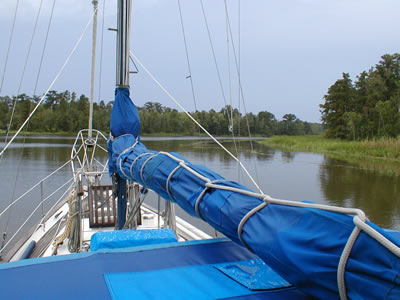
Looking at all of the data and forecasts, we were confident that Hurricane Katrina was going to pass well to the west of Mobile, but decided to take the precaution of moving Landfall to the hurricane hole just in case.
I had wanted to ride out Hurricane Dennis with Tracy in July, but he had persuaded me to stay with friends in Mobile. His argument was that we should not put all of us at risk, and anyway, “someone” needed to stay with Jasmine, our Yellow-collared mini-macaw, because she would probably not be very happy riding out a hurricane, and in any event, would probably just be in the way. It was a sensible (if slightly chauvinistic) argument, and I had reluctantly gone along with it.
It’s not like I could just stay home; Landfall is our home. We’d sold our house in March and moved aboard. We were planning to sail around the world, starting in just a few more months. Tracy was still working, living in hotels during the week and coming home to Landfall weekends. I had quit my job and was working on Landfall full time, getting her ready.
So, Tracy said, if I really wanted to ride out a storm, this would be my chance. Unfortunately, this meant that after two intense and exhausting weeks of classes at the Chapman School of Seamanship, I would have to take the last exam for my Master’s license and then immediately pack up and start driving the 600-plus miles back to Alabama. Lousy timing, but that’s the only way I could get to Landfall before Katrina did.
Tracy left our marina aboard Landfall early Sunday morning while I was still driving back from Florida. By about 3 o’clock Sunday afternoon, Tracy had Landfall anchored in the hurricane hole and I had made it to aptly-named “Hurricane Landing,” a small boat launch just off the Tensaw River and the closest landing for a dinghy pickup back to Big Briar Creek.
One squally deluge later, we arrived at the boat and quickly set out two additional storm anchors and otherwise readied the boat, stripping off more canvas and removing anything that could be blown away.
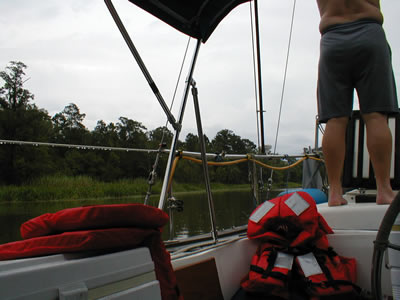
We surveyed our position in relation to the other boats. In our little stretch of the creek, we were last in a line of about six boats. There were at least 30 more boats to the south of these that we couldn’t see from our anchorage, but that we’d passed in the dinghy on the way in. All seemed adequately spaced apart or rafted tightly, and many were tied off to the trees on the bank. These folks had done this before, and we were all getting pretty good at it.
About 200 yards to the north of us the creek rounded a sharp bend to the east. Although we couldn’t see them from where we were, we knew that many more boats were anchored around the bend, some tied off to trees along the bank, others lined up across the creek, rafted up.
By dark, Landfall was ready, and all we had to do was wait for the storm’s arrival, now predicted for the following morning. We felt so snug on our three big anchors and chain that we celebrated with a few cold drinks.
By about 6am on Monday we were beginning to feel tropical storm force winds from the southeast. The normally south-flowing creek had shifted and was now flowing north, with whitecaps. As the morning progressed, water was starting to blow off the wave tops and the wind howled as it pelted rain sideways.
Around 11am, the sailboat on a nylon rode due south of us broke loose and was heading toward us. We watched anxiously as the crew made numerous attempts to re-anchor in the blowing rain, wind and current.
By noon the storm was still strengthening. The wind and water still posed no threat by themselves. However, the debris that had begun to flow toward us did! The normally placid creek had become a surging white-water river full of logs, floating mats of earth, and uprooted trees and branches, all hurtling our way.
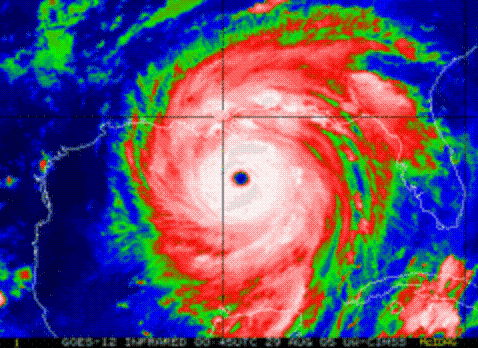
The current was now rushing past us at about 6 knots. Even with our 40hp engine running full throttle, we could not overcome that much current with the wind against us. Just about the time this fact was sinking in, a large uprooted tree hit our main anchor. The root ball tangled in the chain. The trunk was trailing behind the root ball, and the full weight of the tree was on the chain. While Tracy was trying to clear it, the tree’s huge force and weight dislodged the main anchor.
After twenty frantic minutes, we finally swung the tree free. And the two secondary anchors seemed to be handling the load. But before the primary anchor could dig back in, a massive floating island of dislodged riverbank came flying up the creek, aimed directly at us. The floating island was about the size of a large SUV and must have weighed at least a few thousand pounds. Before we could get the engine started to try to dodge it, the floating island wrapped around all three anchor rodes and ripped out all three anchors. Suddenly we were hurtling along with the wind and current at about 6-8 knots. And headed right toward that bend in the creek, and the trees on the bank. And the railroad trestle bridge. And the line of boats around the bend.
That’s when I yelled up to Tracy on the bow. I didn’t want this to be happening. I wanted to let go of the wheel. I wanted to go below and curl up in a ball. I was cold and wet and scared. But I couldn’t leave the helm. So I had to do something. The trees seemed like the lesser evil.
But as I said, I still didn’t like my options. Not one bit. “Think, come on now, there’s got to be something else you can do!” I scolded myself. “You’re in a white water river, in a boat. Forget it’s a sailboat, it’s just a boat in a white water river!”
The light bulb went on. From years of kayaking, I knew that there had to be an eddy, or at least slower water, near the inside of the bend. Gunning full throttle and ferrying Landfall diagonally across the torrent, I was able to maneuver into slower water, while Tracy continued to free hunks of the island of debris. Just when the bow of the boat was out of the worst of the current, Tracy managed to clear enough of the debris to allow the tangled mess of anchors to get a bite in the creek bottom. We felt a sideways tug, and then stopped going backwards.
For the next seven hours, as the current raged and the rain pelted and the wind howled, we kept the engine running and hand-steered the boat to maintain our position in the slower water. The anchors had grabbed the bottom too close to the outside of the bend in the creek so we couldn’t fall back on them without going aground, and we couldn’t reduce scope because we needed all the holding power we would get. But with the engine engaged, and steering toward the inside of the bend, we could stay out of the trees, away from trestle bridge, and ahead of the line of anchored boats. That would have to do.
Trees, logs, and floating mats of earth continued to surge at us; we powered the engine up and down, steering in zigs and zags to dodge the biggest of them. The current was doggedly, persistently, trying to suck us back into the main current. For seven hours, one of us was on the bow keeping the anchor rodes cleared of debris while the other steered around the largest of the floating objects.
To add just a little more excitement, every now and then the engine cooling system clogged, overheating the engine. Each time, we had to shut down the engine to clear the obstruction, then get the engine running again before the boat drifted too far into the main current. We'd power in as close to the bank as we dared and kill the engine. With water streaming into the bilge from the open seacock, Tracy would rapidly clear the hoses and strainer. I’d be at the wheel, anxiously watching the boat drift further into the main current. As soon as Tracy yelled "Clear!" I would restart the engine and power the boat out of the current and into the slower water. Then we’d pump out the bilge. We did that four heart-stopping times.
At one point in the late afternoon, nothing I did seemed to change the engine RPMs. We discovered that the throttle cable had completely disengaged. Tracy raced down to the engine room and fixed that, and quickly, too! Throughout this time, the wind was howling up to 70 knots, blowing water off the wave tops; the rain was pelting our faces like hail; and we were exhausted from cold, stress and now, hunger.
By about 7:30 PM the wind had subsided to “only” tropical storm force, about 25-30 knots. The current had subsided enough to finally shut the engine down and take in a little rode, but still strong enough that we were steering around debris using just the speed of the current to deflect the rudder.
I was mesmerized by the debris surging by, and then noticed that some of it was alive! Frantically swimming snakes, hundreds of long-legged spiders, and whole colonies of ants drifting past, busily leapfrogging each other to climb to the top of the heap, so that only some of the colony were submerged at any one time, but the whole mass stayed afloat. Who’d have imagined that? I wish I'd had the presence of mind to take a picture.
Around 9pm things had calmed down enough for Tracy to take a nap; by 11, he stood watch and I took a nap. By 3am, we were in dead calm. The clouds parted, revealing a black universe bursting with stars. The current swung us as it switched back to the south, toward the Gulf, where it belonged. It’s time, we decided, to go to bed.
We woke a few hours later to a gloriously sunny, calm, blue-sky day, and began the laborious process of untangling the anchor rodes.
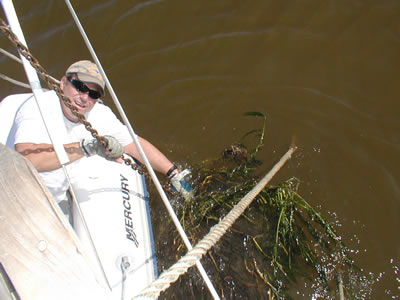
Later, re-anchored and sitting comfortably in the cockpit, we let ourselves reflect on how close we had come to losing Landfall. And how hard we had worked, together, as a team, to keep her safe.
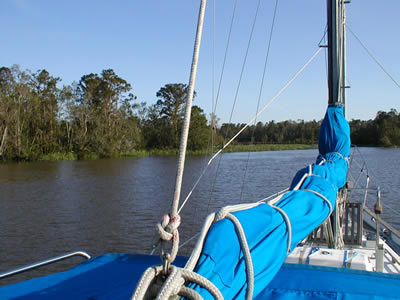

Friends called our cell phones to tell us that our marina was gone, and almost all of the boats that stayed in it were badly damaged or destroyed.
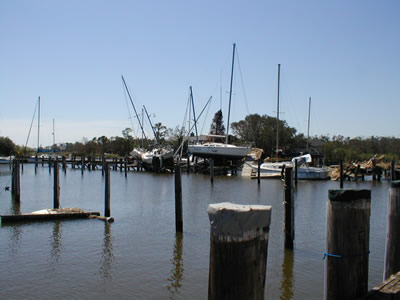
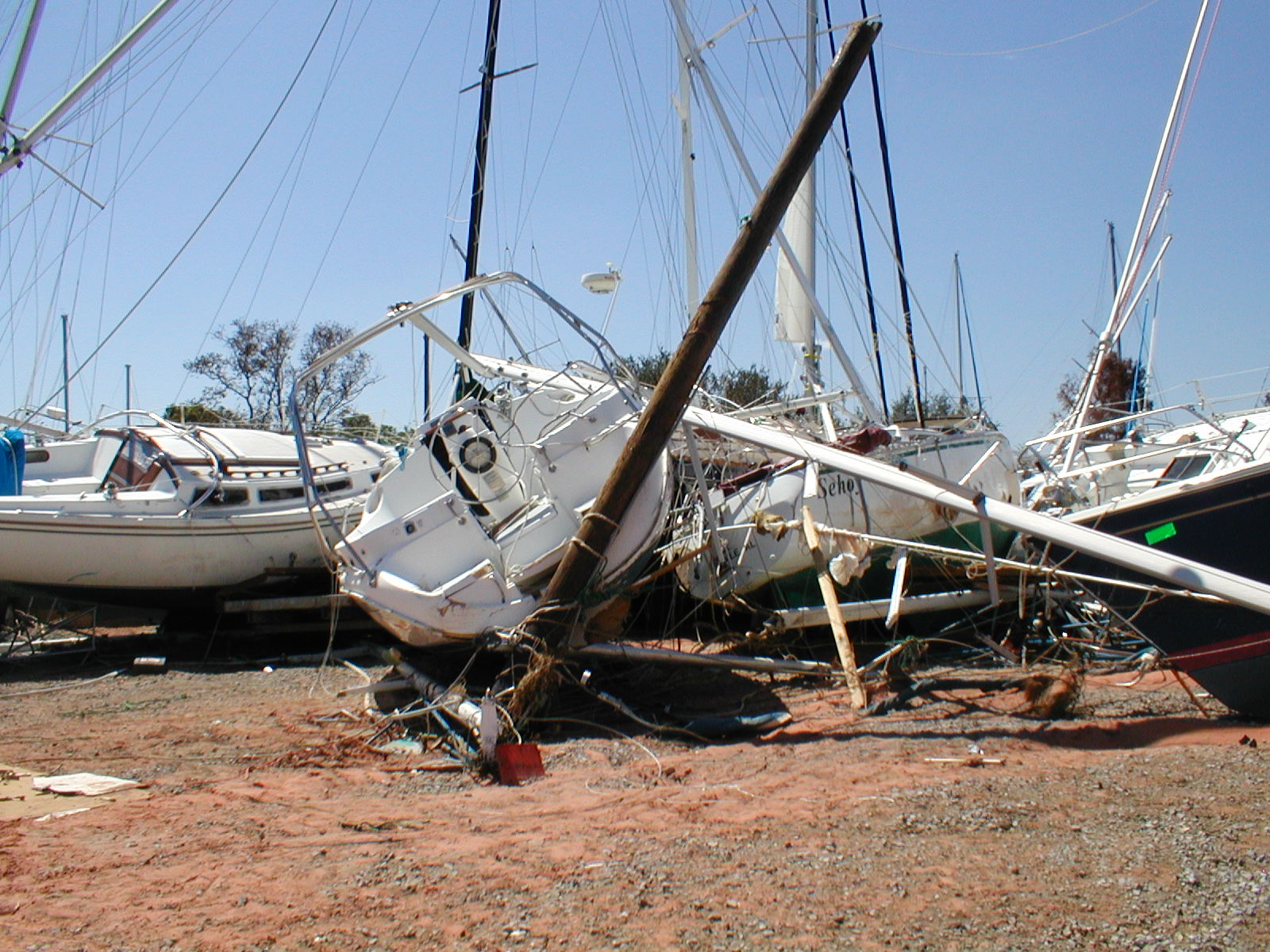
With the Mobile River closed by the Coast Guard for who knew how long, Tracy headed over to Hurricane Landing to search for supplies and gas for the dinghy. While he was off provisioning, I called around and eventually found a marina on the Intracoastal Waterway in Gulf Shores, Alabama that would put us on a waitlist for a slip. Thank goodness for cell phones.
When the Coast Guard opened the river to vessel traffic two days later, we motored our way down in calm winds among broken and missing navigation aids, worried whether we'd have enough fuel to make the trip. We got in on fumes, but with a backup plan to anchor the big boat and take the dinghy boat, with jerry jugs, the rest of the way for diesel fuel if we ran out.
Homeport Marina turned out to be a very well protected, power-boater's marina, with a minimum slip size of 50 feet. We were one of 3 sailboats out of 76 slips. While we initially felt out of place, we’re now thoroughly enjoying the brand new floating docks, the cable TV connection, and the top of the line power connections. Everyone’s been exceptionally friendly, and we’re very happy to be in a safer place!
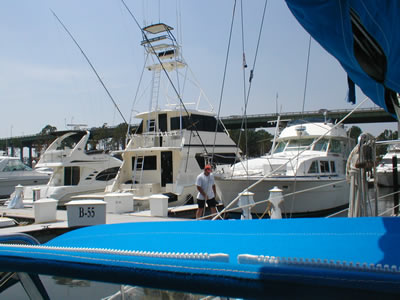
Oh, and the dockmaster and his wife have a Yellow-collared Macaw who looks exactly like Jasmine. They were so surprised to see each other! He's a male, but they don't seem to be flirting in this photo!
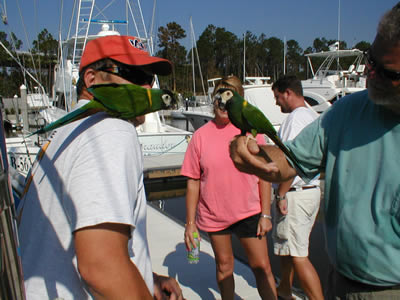
Adjacent to the marina is Lulu's restaurant, owned by Jimmy Buffett's sister, Lucy. Our boat is named after the Jimmy Buffett song Landfall, so how appropriate is that?
|
![]()